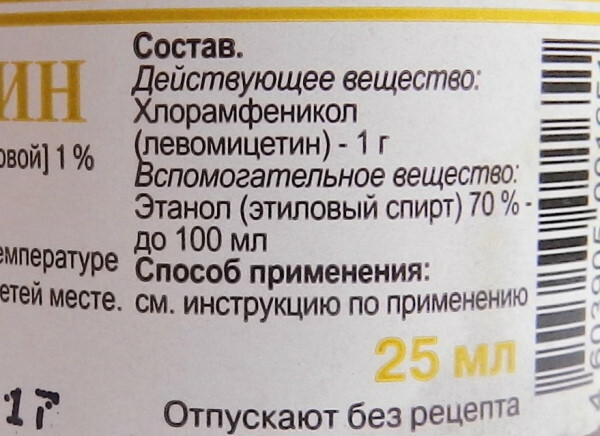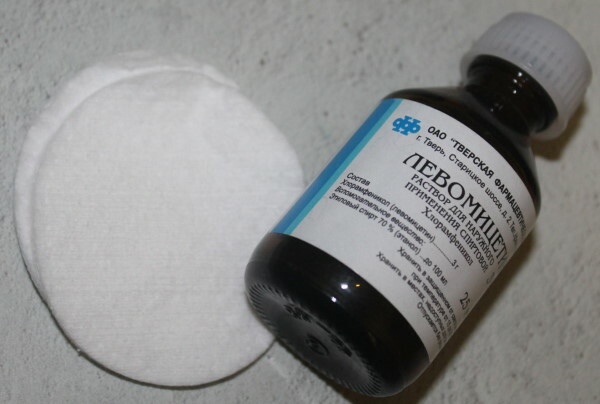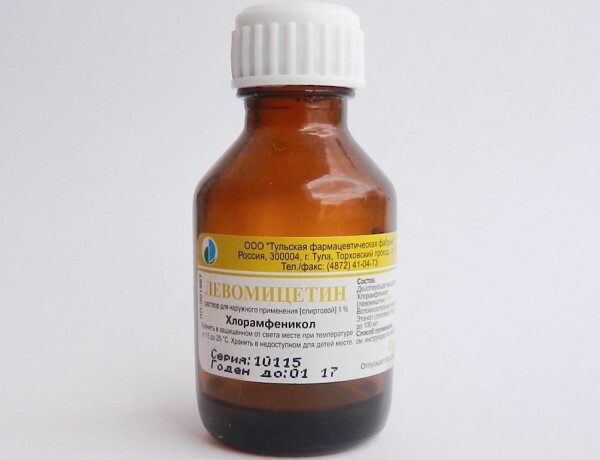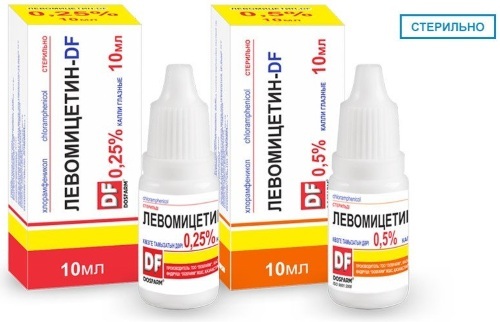Content
- Composition and form of release
- Terms of sale
- Pharmacological properties
- Pharmacodynamics and pharmacokinetics
- Indications for use
- Contraindications
- Method of administration and dosage
- When treating burns
- Use for otitis media
- Alcohol solution of chloramphenicol in the fight against acne and boils
- Side effects
- Overdose
- special instructions
- Drug interactions
- Analogues and prices for the drug
- Storage conditions
- Video about the drug Levomycetin solution
All forms of medicinal products based on chloramphenicol have been shown to be effective for decades. With the correct application of an alcohol solution, containing chloramphenicol for solving problems of wounds and inflammatory subcutaneous processes, the result is noticeable after 2 - 3 procedures.
Composition and form of release
The active ingredient in an alcoholic solution is chloramphenicol. This crystalline substance with a specific bitter taste belongs to the group of antibiotics. It is practically insoluble in water, but completely soluble in ethanol. In addition to medicine, it is actively used in veterinary medicine and animal husbandry. It was first isolated from living cultures in 1947; today it is synthesized artificially.
It affects many groups of bacteria and fungi: chlamydia, spirochetes, ricketssias, gram-positive and gram-negative microbes. It is considered the drug of choice in the treatment of typhoid fever and dysentery, participates in the complex therapy of meningococcal infection.
Differs in extremely high toxicity, therefore, in modern medicine, the appointment for ingestion is extremely rare. It causes serious side effects, the most unpleasant of which is aplastic anemia. External use and local use in ophthalmology does not cause severe and irreversible side effects. It is used as a highly effective antibacterial agent.
Preparations that are produced in the form of an alcohol solution for external use differ from each other in the concentration of ethyl alcohol:
According to the content of the active substance, the preparations of chloramphenicol are divided into forms:
- with a content of 0.25%;
- from 1%;
- 3%;
- 5%.
This means that 100 g of the drug contains, for example, 3 g of chloramphenicol.
The composition as an auxiliary substance (for dissolving crystals of chloramphenicol) includes ethyl alcohol (70%).
The dosage form of the drug is an alcohol solution for external use. Available in dark glass bottles with a volume of 25 or 40 ml. Some manufacturers add outer cartons.
Terms of sale
A solution of chloramphenicol alcohol (only external use) belongs to the group of alcohol-containing drugs that can be used for other purposes. In order to control the sale of ethyl alcohol in pharmacies, as well as all alcohol-containing drugs, there are regulations restricting the sale of such products in pharmacies.
Doctors of all forms of medical institutions are allowed to write prescriptions for dispensing alcohol and alcohol-containing products on special forms with the personal signature of the doctor and the seal of the institution (form "For recipes").
In pharmacies, sell without a prescription only alcohol solutions labeled "for external use" weighing up to 50 g. When dispensing large dosages of the drug, it is necessary to have a prescription with filled-in columns of the form indicating the area of application (for compresses, for treating wounds, etc.).
All pharmacies are required to keep prescriptions for alcohol and alcohol-containing preparations with the manager for at least 1 year. The requirement does not apply to aqueous solutions and mixtures containing any alcoholic tinctures.
For aqueous-alcoholic tinctures (antiseptic, cardiological), a strict requirement has been introduced for the size of the bottle - no more than 25 g, as well as for the amount of the drug in one hand. So the Ministry of Health is fighting the uncontrolled consumption of drugs containing alcohol. You do not need a prescription for 1 bottle.
Pharmacological properties
In the classifier of medicines, the alcoholic solution of chloramphenicol is included in the "antibiotics" group. It has a high antimicrobial activity, which is due to a violation of protein synthesis in the cells of many microbes, and has a bacteriostatic effect.
A feature of the drug is that the active ingredient (chloramphenicol) is active against strains that penicillin, streptomycin, sulfanilamide cannot cope with.
When applied externally, after a single application, the therapeutic effect is observed for 5 - 12 hours. The penetration of the active substance into the systemic circulation is negligible.
Pharmacodynamics and pharmacokinetics
A solution of chloramphenicol alcohol (used externally on the recommendation of a physician) contains active chloramphenicol, which can cause severe toxic side effects when it enters the bloodstream. However, when applied externally after a single application, the therapeutic effect is observed without toxic effects on the body. The penetration of the active substance into the systemic circulation is negligible.
Indications for use
A solution of chloramphenicol alcohol (the use of the drug is limited in time and dosage, which are determined individually) when used externally, the pharmacokinetics are loyal, but the drug is not recommended for pregnant women and in lactation period.
Problems that alcohol chloramphenicol is able to solve:
- external purulent eruptions on the skin of the face and back;
- subcutaneous abscesses;
- boils;
- acne;
- eczema;
- non-purulent inflammation of open wounds and scratches;
- otitis;
- bedsores.
Contraindications
The drug is contraindicated in women during pregnancy and during breastfeeding.
The main cases of contraindications:
- individual intolerance to the active substance in the composition of the solution;
- disorders of bone marrow circulation;
- deficiency of glucose-6-phosphate dehydrogenase;
- hepatic or renal failure;
- fungal skin diseases;
- psoriasis;
- early childhood;
- period of radiation therapy.
When used in elderly patients, it can provoke an exacerbation of chronic diseases.
Method of administration and dosage
The drug is intended for external use only. To apply the solution to adults and children over 6 years old, sterile gauze wipes or cotton pads are used. Can be used in compresses covered with parchment paper and a fixing bandage. They are changed on the recommendation of a doctor with a frequency of 1 to 3 days.
In cases of complex infectious lesions of the skin and ear, an alcohol solution is combined with a tablet antimicrobial drug. The duration of therapy is determined by the attending physician.
When treating burns
It is prescribed for external use in the treatment of wounds in the second phase of the process, in the absence of suppuration. It is recommended for use in the complex therapy of II - III degree burns, with the appearance of an additional focus of infection. To do this, problem areas of the skin are treated with a swab dipped in a 3% solution of chloramphenicol, several times a day.
Alcohol chloramphenicol has also established itself as the drug of choice in the prevention and treatment of pressure ulcers and trophic ulcers.
Use for otitis media
Inflammatory processes in the organs of hearing are often found both as an independent disease and as a complication in the course of viral and bacterial infections. Most often, the focus of inflammation is located in the middle ear - otitis media. It may be accompanied by an increase in body temperature up to 39 ° C, while the patient feels general weakness, congestion in the ear, which is often accompanied by pain of varying degrees of manifestation. In difficult cases, purulent discharge from the auditory canal is possible.
According to medical statistics, the inflammatory process of the middle ear in 90% of cases is provoked by staphylococci. The doctor, based on the results of bacterial sowing, determines the type of antibiotic in drops that must be used according to the scheme.
On the basis of an alcohol solution of chloramphenicol, ear drops are created, which can be recommended for the treatment of acute catarrhal otitis media in adults and children over 14 years old. However, before using them, you should make sure that the tympanic membrane is intact, as alcohol can cause hearing loss on contact with the auditory nerve.
For instillation, a 0.25% alcohol solution of chloramphenicol is used, if the percentage is higher, it is necessary to dilute the drug with boiled water to the desired concentration.
Rules for using an alcohol solution of chloramphenicol for ear instillation:
- The temperature of the solution should be 36 - 37 ° C. To do this, it is recommended to hold the bottle with liquid in your palms for about 10 minutes.
- Before the procedure, you need to thoroughly clean the ear canal from sulfur and purulent discharge (if any) using a cotton swab. In this case, it is forbidden to use other cleaning agents and to insert them deeper than 0.5 cm into the ear canal.
- Before instillation, the pipette must be kept in boiling water (thoroughly cleaned inside) and dried in air.
- It is recommended to take a small dose of the drug (2 - 3 drops) and bury them on the wall of the ear canal, through which they will independently flow to the site of infection. Patient position: lying on a healthy ear, with his head lowered slightly downward.
- After instilling the medicine, the patient's position should remain unchanged for 20 - 30 minutes.
To avoid leakage of drug residues after changing the position of the patient, you can close the ear with a cotton swab (do not stick it deep into the auditory canal).
If there is a risk of violation of the integrity of the tympanic membrane, then the instillation procedure is replaced with applications. To do this, twist the turunda out of sterile cotton wool with clean hands and moisten it with an alcohol solution. Insert one end into the ear canal and leave for 20 minutes. In this case, the position of the patient is lying on his side, with the sore ear up.
The procedures are carried out no more than 2 times a day, observing the interval between manipulations of 12 hours. The course of therapy is designed for 1 week. If after 3 days there is no visible relief of symptoms, further treatment is impractical and the situation requires a doctor's consultation.
Alcohol solution of chloramphenicol in the fight against acne and boils
The drug has been successfully used to treat external and internal (deep, subcutaneous abscesses) acne. It is effective for acne. However, the methods of use are different depending on the problem. For example, for the prevention and elimination of acne, it is necessary to wipe the face with a 0.25% solution once a day, and for the treatment of subcutaneous acne, it is recommended to apply the solution pointwise, every 3 to 4 hours.

There are several options for using alcoholic chloramphenicol in the composition of cosmetic products mixed with other components - masks, talkers, applications.
Acne Talker Recipe
A chatterbox is a thick mixture of several components, which is kneaded in a dark glass container and stored in the refrigerator. Apply the remedy pointwise to the area of inflammation twice a day.
Talker options for acne elimination:
| Name | Components |
| With salicylic acid | It is necessary to mix 5 ml of salicylic acid and 2 ml of alcoholic chloramphenicol, dissolve 1 tablet of Metronidazole in them. |
| With calendula | Mix 10 ml of calendula tincture with 5 ml of alcoholic chloramphenicol, dissolve 2 tablets of salicylic acid (aspirin) in them. |
| Levomycetin and streptocide | Mix 30 ml of camphor alcohol with 20 ml of alcoholic chloramphenicol, add 5 streptocide tablets and 2 salicylic acid tablets to the solution. |
| With boric acid | Combine together 20 ml of chloramphenicol, salicylic alcohol and boric acid. |
| With Trichopolum | Dissolve powder from 2 tablets of Trichopolum in 25 ml of chloramphenicol alcohol. |
The maximum period of use of chloramphenicol with chloramphenicol is 2 weeks with daily use.
Acne face masks:
| Name | Components |
| With cosmetic clay | 2 h l. alcohol chloramphenicol mix with 50 ml of broth on calendula, add 1 tbsp. l of cosmetic clay, apply on a clean face for 15 minutes. |
| With honey | 2 h l. alcohol tincture of chloramphenicol mix with 1 tbsp. l. honey, dissolve 2 Aspirin tablets in a mixture. |
| With chamomile infusion | Chamomile infusion 5 tbsp connect with 2 tsp. l. alcoholic chloramphenicol, add 1 tsp. l. honey and 2 tablets of Aspirin. |
| With starch | Mix 1 tsp. l. starch and 0.5 tsp. l. alcohol chloramphenicol, add 10 ml of herbal decoction (string, chamomile, calendula). |
Masks have a high activity of the constituent components, so they are applied 1 - 2 times a week for 10 minutes. on cleansed skin.
Side effects
A solution of chloramphenicol alcohol (application is possible only externally and pointwise) due to the toxic active substance is capable of provoking various side effects. To minimize negative manifestations, doctors recommend limiting the course of therapy in time (when a positive effect is achieved, immediately stop using the drug).
Since the drug is used externally, allergic reactions from the skin are most common:
- itching;
- peeling of the skin around the site of use;
- visible redness that does not go away for a long time;
- hyperemia (redness with a local increase in temperature);
- hives around the site of use.
Less common side effects from the circulatory system - aplastic anemia, thrombocytopenia, agranulocytosis. Such anomalies were recorded after long courses of drug use in a small number of patients.
Overdose
Long-term courses of use of the drug (more than 14 days), frequent use during the day (8 - 12 times) will lead to the appearance of side effects, which are described above in the article. Cases of edema and an increase in body temperature have been recorded.
If negative manifestations occur, you should stop using the solution and undergo therapy with antihistamines.
special instructions
Due to the toxicity of the active substance, the drug is used with caution in the treatment of children and adolescents. Its use in infants is strictly prohibited, since there is a high likelihood of "gray syndrome", which is characterized by blue skin, cyanosis, nausea against the background of increased methiorism.
Patients who have previously undergone radiation therapy are allowed to use the drug only under the supervision of a family doctor.
When using the drug in children and the elderly, it is necessary to monitor the peripheral blood. It is worth avoiding the use of the drug for mild inflammatory processes.
Drug interactions
Negative effects with the simultaneous use of an alcoholic solution of chloramphenicol and other external and oral agents have not been recorded.
Analogues and prices for the drug
When choosing analogs of the drug, it should be remembered that there is a classifier according to groups of analogs.
How are analogues of medicinal products divided by properties:
- Full analogues - these are drugs that consist of the same active substances and have a similar release form.
- Group analogues - preparations that contain active substances similar in pharmaceutical properties and a similar release form.
- Nosological analogues - a category that is available to narrow specialists for replacing a drug with a similar one (with other active substances), but with the same therapeutic effect.
The solution of chloramphenicol alcohol according to the effect of the application can be replaced by other alcoholic antiseptics. The decision to replace the recommended drug can only be made by a doctor who predicts the result after treatment with an analogue. Replacement drugs are selected from group or nosological analogues.
A similar therapeutic effect after application has:
- liniment synthomycin for external use;
- levomekol ointment;
- salicylic acid 1% or 2%;
- a mixture of salicylic acid and chloramphenicol (1: 1), 2% each;
- furacilin solution 1: 1500;
- resorcinol 1% or 2%;
- a mixture of chloramphenicol (1%) and novocaine (2%);
- chloramphenicol gel;
- chloramphenicol;
- levovinisole.
Many of the drugs listed above contain an active ingredient - chloramphenicol.
Prices for analogs and other forms of drugs with chloramphenicol:
| Name | Manufacturer | price, rub. |
| Levomycetin eye drops 0.25%, 10 ml | Lecco | 42 |
| Levomycetin vials 1%, 25 ml | Levomycetin vials 1%, 25 ml | 88 |
| Levomycetin tablets 500 mg, 20 pcs. | Dalhimpharm | 88 |
| Levomycetin vials 3%, 25 ml | Ivanovskaya pharmaceutical factory | 133 |
The alcoholic solution of chloramphenicol has no direct analogue.
Storage conditions
An alcoholic solution of chloramphenicol is available in dark glass vials to avoid interaction of the liquid with sunlight. However, you should additionally store the medicine bottle in a dark, dry place. The optimum storage temperature is up to 15 ° C. The shelf life of the solution is calculated for 1 year from the date of manufacture.
A solution of chloramphenicol alcohol, when applied correctly and in a timely manner, can solve many skin problems. In addition to treating open wounds, the drug is successfully used for the treatment and prevention of adolescent acne and purulent boils at any age. Effectively proved itself for the treatment of wounds and scratches in children (during the initial treatment of abrasions).
Video about the drug Levomycetin solution
Levomycetin. Instructions for use:



